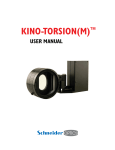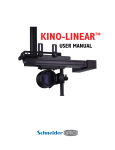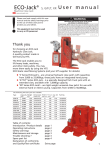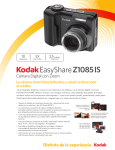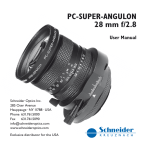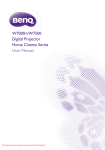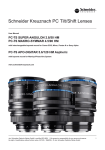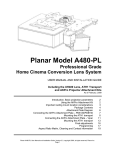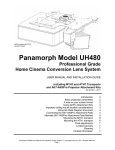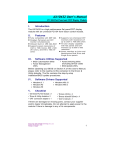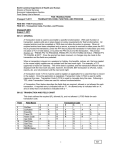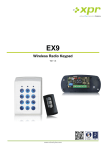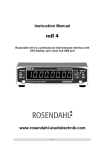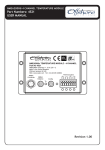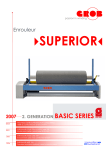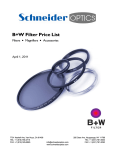Download Kino-Torsion User Manual - Hill Residential Systems
Transcript
™ KINO-TORSION USER MANUAL CONTENTS Welcome . . . . . . . . . . . . . . . . . . . . . . . . . . . . . . . . . . . . . . . . . . . . . . . . . . . . . . . . . . . . . . . . Page 1 Inside the Box . . . . . . . . . . . . . . . . . . . . . . . . . . . . . . . . . . . . . . . . . . . . . . . . . . . . . . . . . . Page 2 Attachment of Lens to Kino-Torsion™ Mechanism . . . . . . . . . . . . . Page 3 Electrical Connections . . . . . . . . . . . . . . . . . . . . . . . . . . . . . . . . . . . . . . . . . . . . . . . . Page 4 Attachment of Kino-Torsion™ to Chief Ceiling Mount . . . . . . . . Page 5 Adjusting the Anamorphic Image . . . . . . . . . . . . . . . . . . . . . . . . . . . . . . . . . . . . Page 6 About Schneider . . . . . . . . . . . . . . . . . . . . . . . . . . . . . . . . . . . . . . . . . . . . . . . . . . . . . . Back Cover WELCOME Congratulations on your purchase of a Schneider Optics, Inc. Kino-Torsion™ anamorphic system. This system is composed of the finest optical and mechanical components available. The Cine-Digitar Anamorphic lens is of commercial grade and should last indefinitely provided that it is used within reasonable parameters of temperature and shock. The mechanical assemblies within the Kino-Torsion™ lens mover are designed for the demanding duty cycle of a professional screening room and have been tested to simulate in excess of 10 years use. Installation by a qualified professional is recommended for best results. Page 1 INSIDE THE BOX The following items are included in the Schneider Optics Kino-Torsion™ packaging: A. Kino-Torsion™ Motorized Lens Mechanism B. Power Supply (12-volt output, 110-240-volt input) C. 3 Power Cord Types (US, UK, EU) D. 12-Volt Trigger Cable (3.5mm Phono Type, Mono, 3M, Male-Male) E. - Lens Retaining Ring - Two Retaining Ring Screws (M3x6mm, Phillips head) Note: A Cine-Digitar Anamorphic lens is required to use the Kino-Torsion™ and must be purchased seperately. Page 2 ATTACHMENT OF LENS TO KINO-TORSION™ MECHANISM Tools Needed: 1. Screwdriver: No.1 Phillips 2. Allen Wrench: 1/16”, 1/8” 3. Ball End Allen Wrench: 4mm (Important for Mounting Bolts) Assembly Instructions: 1. Remove Kino-Torsion™ mechanism and Cine Digitar anamorphic lens, if purchased together, from packaging. Inspect all components for damage that may have occurred during shipping. 2. Insert lens into the frame clamp of the KinoTorsion.™ The lens should seat firmly into the clamp. Further loosen the frame clamp lock screw if needed. See Illustration #1. Illustration #1 - Rear View of Kino-Torsion™ with Lens Installed 3. Insert the retaining ring into the frame clamp and tighten the two retaining ring screws. 4. Align the lens, rotating it until the flat sides of the inner bezel are vertical. Tighten the frame clamp screw. See Illustration #2. Illustration #2 -Front View of Kino-Torsion™ Page 3 ELECTRICAL CONNECTIONS 1. Select the appropriate power cord (US, UK, EU) for your location, and connect the power supply to the Kino-Torsion™ and electrical outlet. A green LED should go on if power is working correctly. A flashing LED indicates that power is not correct. See Illustration #9. 2. When the Kino-Torsion™ receives 12 volts through this connector, the lens moves out of the projector view. When the voltage is zero, the lens moves back into projector view. A 12-volt trigger must be supplied by a programmable 12-volt source on the projector, video scaler, or home theater control system. A 3 meter trigger cable is provided. Illustration #3 -Electrical Connection Area 3. Test Kino-Torsion™by triggering unit and observe motion. Trigger <ON> should move lens away. Trigger <OFF> restores original position. 4. As an alternative or local testing, the Kino-Torsion™ can also be controlled via simple contact closure without a 12-volt trigger. Use a wire to connect terminal 1 to 2. This will move lens out of the projector view when connected, similar to using the 12-volt trigger. 5. To gain access to the terminal block, the motor cover needs to be removed. Unscrew the motor cover screws with 1/16” allen wrench, and carefully pull back cover. See Illustration #4. Illustration #4 -Detail of Electrical Connection Area Page 4 ATTACHMENT OF KINO-TORSIONTM TO CHIEF CEILING MOUNT Accessories Needed: 1. Chief MFG, CMS Column, or 1.5” NPT pipe of suitable Length. (Chief CMS™) 2. Chief MFG, RPA LCD/DLP Universal Ceiling Mount. (Chief RPA™) 3. Chief MFG, SLBU/SLMU Universal Interface Bracket, or custom interface bracket (not shown) for your specific projector. 4. Chief MFG, PAN-2 Panamorph Lens Support. (Chief PAN-2™) 5. Schneider Optics, Kino-Torsion / PAN-2 Bracket (#54-018712). Illustration #5 - Detail of Chief PAN-2 Lens Support Assembly Instructions: 1. Install the Chief CMS™ Column and Chief RPA™ Universal Ceiling Mount as instructed in Chief manual. 2. Attach the Chief PAN-2™ lens support to Chief RPA™ Universal Ceiling Mount as instructed in Chief manual. 3. Replace the 90-degree adapter supplied with the Chief PAN-2 lens support with the Schneider PAN-2 bracket. See Illustration #5. Illustration #6 - Schneider Kino-Torsion™ PAN-2 Bracket 4. Mount projector interface bracket (universal/ custom) to the projector. Then place entire assembly into the Chief RPA™ Universal Ceiling Mount. 5. Mount the Kino-Torsion™ onto the Schneider PAN-2 bracket with the mating holes. Use a 5/32” ball end allen wrench to tighten the two 10-32 mounting bolts. Adjust knobs to align the vertical position of the lens if needed. See Illustration #7. Illustration #7 - Chief Mount Page 5 ADJUSTING THE ANAMORPHIC IMAGE 1. If focusing projector for the first time, use the 12-volt trigger controller to take the lens out of the light path of the projector. Follow projector manufacture instructions for setting up image. 2. <Important> Use the adjustments on the Chief RPA™ Universal Ceiling Mount as much as possible to center image. Internal projector image adjustments should be centered as mush as possible for proper alignment to the anamorphic. 3. Deploy the anamorphic lens into the projector light path using the controller (Trigger OFF), checking to assure that no part of the lens or cradle contacts any part of the projector. Observe image using the projector test grid pattern. Illustration #8 - Detail of Chief Mount 4. If you see vertical “vignette” distortion on top or bottom, adjust the height of the anamorphic lens. Use either the vertical adjustments on the Kino-Torsion™ or the knurled knobs on the Chief Mount. 5. If you see left or right side “vignette” distortion, adjust the yaw on the Kino-Torsion™ or the knurled knobs on the Chief Mount. 6. If you see “trapezoidal”, “barrel”, or “pincushion” distortion, adjust the pitch on the Kino-Torsion,™ and yaw if necessary. 7. If you see “parallelogram” distortion and stretched corners, adjust lens rotation (roll). See Illustration #2. 8. If the image requires focusing, loosen the lens focus knob on the Schneider Anamorphic lens to adjust. Illustration #9 - Front Detail Page 6 ABOUT SCHNEIDER Schneider Optics is the U.S. subsidiary of the world-renowned German optical manufacturer, Schneider-Kreuznach. Schneider has been producing the highest quality optics on the market for over 90 years, offering solutions for large-format photography, photo enlarging, motion picture projection, optical filtration, and industrial applications. In 2000, Schneider Optics acquired Century Precision Optics, adding its over 50 years experience manufacturing superior attachments for film and video. The factory is fully compliant with ISO 9001 standards. Its U.S. subsidiary, Schneider Optics, was founded in 1972. Schneider Optics has offices in Hauppauge, NY and Van Nuys, CA and a network of hundreds of dealers around the globe, ready to assist you with any of your imaging needs. Seperately the two companies were leaders in their respective spheres of the optical world—both having been awarded Technical Achievement Awards from the Academy of Motion Picture Arts and Sciences (Schneider in 2005, 2001, 1978 and 1976; Century in 1992). Together they are the ultimate solution to all your optical needs. Joseph Schneider founded the company in 1913 in Bad Kreuznach, Germany. Since that time the Schneider factory has been constantly modernized, always remaining state-of-the-art. Century Optics first opened its doors in North Hollywood, CA in 1948, and quickly gained a reputation for expert lens repair, custom modification and intelligent innovation. In the early 80’s Century began creating what has become the most extensive array of ultra-high quality video lens accessories available anywhere. Schneider Optics, Inc. 7701 Haskell Avenue Van Nuys, CA 91406 Phone: +1 818 766-3715 • +1 800 228-1254 Fax: 818 505-9865 Email: [email protected] www.schneideroptics.com Schneider Cinema Projection Lens technology has won four Technical Achievement Awards from the Academy of Motion Picture Arts and Sciences Jos. Schneider Optische Werke GmbH Business Unit: Cinema Ringstr. 132 • D-55543 Bad Kreuznach Phone: ++49-(0)671-60 12 82 Fax: ++49-(0)671-60 11 08 Email: [email protected] www.schneiderkreuznach.com 9010-0051 Rev 1.31








